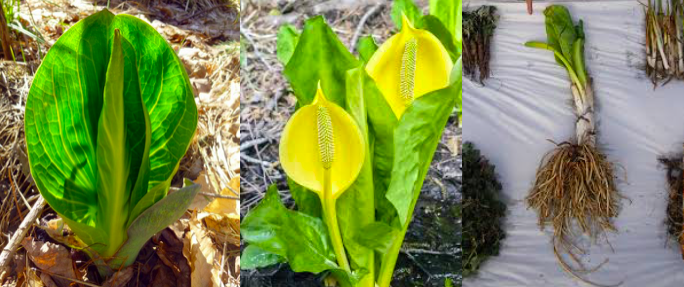Yellow Skunk Cabbage

Figure 1: Skunk Cabbage (weblinks noted under references)
Common and Latin Name:
Skunk cabbage, Symplocarpus foetidus (Goslee et al., 1997)
First Nation Names:
Hulkemel’em name, down river: c’aqwe’
Island Hulkemel’em name, c’aqwa (SFU, 2017)
Family:
Arum (Seymour, 2004)
Identification:
Yellow Skunk Cabbage is an ephemeral, perennial plant, with leaves reaching up to 1.5m tall. A yellow hood, or bract which is part of the plants reproductive system covers the flower. The main flower or spadix contains very small individual flowers is, with pollen and is located at ground level (Muma, 2017). Leaves sprout from a central stem and surround the flower. The foliage is bright green, smooth and has a waxy coating. Skunk cabbage leaves contain pinnate veins with a strong centre vein. Skunk cabbage leaves grow in a rosette fashion compared to hellebore were the leaves alternate. Roots can extend as far a meter into the ground.
Yellow skunk cabbage is a unique plant that is capable of the process thermogenesis, meaning the plant is capable of producing its own heat. The process is a function of the spadix, or flower. As a result, yellow skunk cabbage sprouts during the early spring, often through unfrozen ground (Seymour, 2004; USDA, 2017).
Cautions:
Skunk cabbage has a very similar look alike, the black hellebore (Veratrum viride). The black hellebore grows in similar habitats as the skunk cabbage and is extremely poisonous however, the venation is different between plants. For black hellebore the veins run parallel from the bottom of the leaf to the tip (Angelyn, 2013).
Skunk cabbage also contains calcium oxalate crystals. These crystals can result in burning sensations if consumed. If roots are used for consumption it is recommended that water is changed multiple times before consumption.
Current Distribution and Local Habitat:
Skunk cabbage may be ground in north-eastern and western North America and East Asia (Seymour, 2004). Skunk cabbage requires a wet habitat and therefore is commonly found in swamps, marshes and along river beds. On the UVic Campus, skunk cabbage is primary found at the Bowker Creek headwaters.
Ethnobotanical Uses:
Skunk cabbage roots contain medicinal properties such as antimycobacterial, anti rheumatic and dermatological; for example the Iroquois have traditionally used skunk cabbage roots for these properties (Webster et al., 2010). Skunk cabbage leaves have a waxy coating and were commonly used for temporary drinking cups, lining berry baskets, wrapping food, specifically salmon and pit cooking. During times of famine, when yew wood was difficult to come by to make fish hooks, the roots of skunk cabbage were used instead (Foster, 2014). Leaf poultice can be used as a medicine for ailments such as swelling, boils, burns and sores. Roots can be steamed and ground for tea to relieve ailments such as coughs, purifying of the kidneys and blood as well as to ease labour pains (Krohn, 2017).
View presentation of making salve with skunk cabbage
Written by: Natasha Ewashen
References:
Angelyn, 2013. Identify that plant: A skunk cabbage “looks similar”. Retrieved from: http://identifythatplant.com/a-skunk-cabbage-looks-similar/
Foster, 2014. Swam Lanterns A.K.A. Skunk Cabbage. Retrieved from: http:// www.mossomcreek.org/swamp-lanterns-skunk-cabbage/
Goslee, S. C., Brooks, R. P., & Cole, C. A. (1997). Plants as indicators of wetland water source. Plant Ecology, 131(2), 199-206.
Krohn, 2017. Wild food and medicines: Skunk cabbage. Retrieved from: http:// wildfoodsandmedicines.com/slider-1/
Muma, 2017. Ontario Wildflowers: Skunk Cabbage. Retrieved from: http:// ontariowildflowers.com/main/species.php?id=105
Seymour, R. S. (2004). Dynamics and precision of thermoregulatory responses of eastern skunk cabbage Symplocarpus foetidus. Plant, Cell & Environment, 27(8), 1014-1022.
SFU, 2017. Native Peoples, Plants & Animals: Halkomelem. Retrieved from: http:// www.sfu.ca/halk-ethnobiology/
USDA, 2017. Conservation Plant Characteristics: Symplocarpus foetidus. Retrieved from: https://plants.usda.gov/java/charProfile?symbol=SYFO
Webster, D., Lee, T. D., Moore, J., Manning, T., Kunimoto, D., LeBlanc, D., ... & Gray, C. A. (2010). Antimycobacterial screening of traditional medicinal plants using the microplate resazurin assay. Canadian journal of microbiology, 56(6), 487-494.
Images:
From left to right:
https://nhgardensolutions.wordpress.com/tag/skunk-cabbage/page/3/
https://gardenerdy.com/skunk-cabbage-plant
http://www.twineagles.org/skunk-cabbage.html
